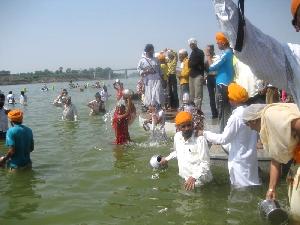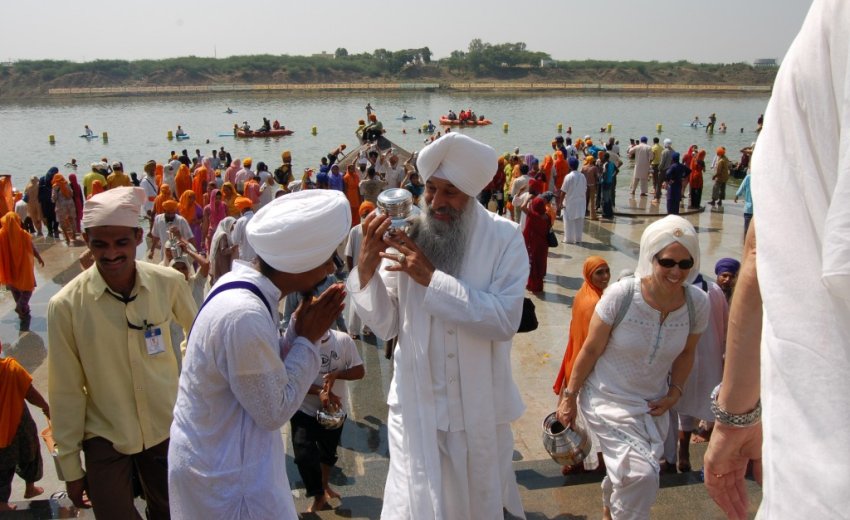 Sikh pilgrims walked with pitchers, carrying water from the holy Godavari river to Sachkhand Shri Huzur Sahib. Commoners can perform takht snan just once a year
Sikh pilgrims walked with pitchers, carrying water from the holy Godavari river to Sachkhand Shri Huzur Sahib. Commoners can perform takht snan just once a year
It was an experience devout pilgrims will cherish their entire life. The dawn on Monday in the historic city of Nanded unleashed the energies of thousands of Sikh pilgrims, who, clad in traditional attire, took a dip in the Godavari river, filled their pitchers and chanted Guru-naam as they walked to Sachkhand Shri Huzur Sahib in the thousands to perform takht snan, a symbolic of the cleansing of the holy place where their tenth and last mortal Guru changed the course of their history 300 years ago.
Nanded kept its tryst with history, even as thousands of Sikh devotees awash in an unprecedented religious fervour participated in the tercentenary ritual of purifying the shrine ahead of the Guru-ta-Gaddi diwas.
The turnout, drove the city back to historic times, when Guru Gobind Singh lived and walked here. “Such a fascinating sangat (pilgrims) gives us inspiration and energy,” remarked Raghbeer Singh, a local farmer visibly lost in a trance as he scurried past the shrine entrance and emptied his pitcher on to the Sachkhand stairs, in a symbolic act of purifying the Gurdwara.
“I attend the event every year,” said Lakhvinder Singh, another local, “but I have never seen such a turnout of devotees before.” Even today, he believed, the divine presence of the Guru could be sensed and experienced. Thousands others — men and women of all ages and every strata — walked with pitchers on their shoulders after taking a dip in the river, under a tight veil of security and the watchful eyes of lifeguards. Takht snan is done every day, but the common people could perform it only once a year as part of their seva.
Nanded SP Ravindra Singhal said elaborate security arrangements had been made in and around the Sachkhand Gurdwara premises and across the city, with a total deployment of 7,500 policemen. “Constables have been provided with special kits comprising first aid material and water bottles to sustain them through the long hours of duty. Similarly, plainclothes policemen and Quick Response Teams have been deployed as a part of a thick security blanket around the venue.”
Remarked 65-year-old Balwinder Kaur, a pilgrim from Amritsar, who looked tired but excited: “It’s a once-in-a-lifetime-opportunity for us to offer respects to the tenth Guru and perform takht snan with our hands. The ritual reinforces the thought of being humble, an important tenet of Sikhism and teaching of Guru Nanak. It is a seva, and we are reaching the Guru.”
Slogans like Satnam Wahe Guru, raj karega khalsa, and Bole so nihaal… sat sri akal reverberated in the air, as pilgrims poured on to the roads leading to the Sachkhand, from Nagina Ghat Gurdwara. The much-awaited ceremony began early, but picked up momentum around 9.30 am, when the chief ghagrya (Gurdwara pitcher man) performed the pooja at the riverside and carried water to the Sachkhand, to be followed by the sangats.
The entire 1.5 km stretch, from the banks of the Godavari to the Gurdwara, was a sea of humanity, as devotees participated in the grand ceremony.
Sikh pilgrims cleaned the sanctum sanctorum by fetching water thrice from the Godavari and twice from Bawdi-sahib, a historic well located behind the Sachkhand. It is considered a part of their seva during the takht snan, strictly adhering to the centuries-old tradition preserved by this Gurdwara. The auspicious snan, which also kick-started the Guru-ta-Gaddi tercentenary festivities, is held a day before Diwali every year.
Besides this, 4,000 historical weapons and clothes, including headgear and palkhis of Guru Gobind Singh and Maharaja Ranjit Singh (who built the Sachkhand) were purified and kept for public display in the sanctum sanctorum.
The weapons were brought out into the open after the chief jatthedar of Sachkhand, Sant Baba Kulwant Singhji, performed the ardas pooja. His deputy, the mit-jatthedar, Jyotinder Singhji, performed another pooja, paying obeisance to the weapons, following which the ghagrya went to the Godavari where he performed an ardas and sought permission from the river to carry her water for the takht snan.
By Jaideep Hardikar & Nadeem Inamdar

